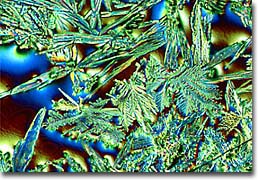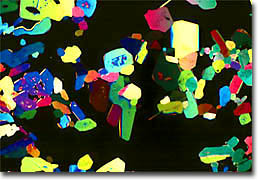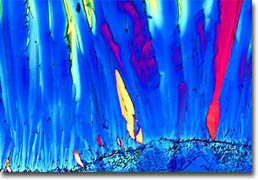|
Each cell in the human body contains thousands of different proteins, the most abundant and diverse class of biomolecules. Proteins are, in fact, present in the cells of all living organisms, though each different species contains a slight to major variation in the number and type of the biomolecules so that there are literally millions of different proteins that exist in the biological world. Proteins play a major role both in cellular structure and function, some being involved in such activities as transport, catalysis, storage, contraction, and protection, while others form critical parts of the cytoskeleton. The types of protein differ from cell to cell, but all have the same basic structure with respect to the constituent amino acids that make up the backbone. Most proteins are biological macromolecules that range in molecular weight from about 6,000 to several million Daltons. They are all polymers that are composed of covalently linked amino acids. The number, chemical nature, and sequential order of amino acids in a protein chain determine the distinctive structure and characteristic chemical behavior of each protein.

Cytochrome C
The native conformation of a protein is determined by interactions between the polypeptide backbone, its substituents, and the aqueous environment. The protein folds in a manner that attains an energetically stable but generally complex three-dimensional structure, which was first discovered by Swedish chemist Jöns Jacob Berzelius in 1838. There are four levels of structure that interdependently influence a protein's biologically functional conformation. The primary structure of a protein refers to the number and sequence of amino acids in the backbone. The secondary structure is determined by the amount of structural regularity contained in a polypeptide, as a result of hydrogen bonding between peptide groups. The tertiary structure is driven by the environmental variables that a protein encounters as it is being synthesized. This structure is the actual three-dimensional structure of the protein. Quaternary structure is the final complex formed between two or more peptide chains.

Albumen
Proteins are generally classified as either fibrous or globular. The fibrous proteins are composed of polypeptides that are often highly cross-linked by various types of bonding to yield tough and water-insoluble structural proteins such as hair, skin, collagen, tendons, and silk. Some fibrous proteins are also involved in constructing the important cellular components known as microtubules. The protein tubulin is particularly important in this regard, while another fibrous protein called fibrin is central to the formation of blood clots. In contrast, globular proteins tend to be highly soluble due to the many clusters of atoms they contain that are electrically charged. As indicated by their name, globular proteins are also characterized by their spheroid, compact structures. Generally biologically active, enzymes and antibodies are the two primary types of globular proteins.

Leptin
A certain amount of protein must be consumed through the diet in order for human nutritional needs to be met. For such purposes, proteins are usually considered to exist in both complete and incomplete forms. Sources of complete proteins contain all of the amino acids that the human body is unable to manufacture itself, while incomplete proteins lack one or more of the essential amino acids. Most animal-derived foods contain complete proteins, which are the only proteins included on nutritional labels. Vegetables and other plant-based foods typically only provide incomplete proteins to the body. This fact can sometimes be problematic for vegetarians, since obtaining little or none of any of the essential amino acids can cause significant health problems. However, this potential drawback to vegetarianism can be easily avoided if a wide variety of plant foods are eaten regularly since different types contain different amino acids. In former times, it was commonly believed that vegetarians must imbibe all amino acids in a single meal in order to maintain health, but it has been since realized that this is not necessary as long as they are all consumed daily.

Hemoglobin
Proteins are necessary to the body in a relatively fixed ratio and can become problematic if present in quantities that are too small or too great. A protein deficiency is characterized by a number of symptoms including irregular hormonal activity, hair loss, decreased muscle mass, fatigue, resistance to insulin, and decreased body temperature. In severe cases, protein deficiency can lead to death. Excessive bodily levels of protein are likewise associated with hazardous effects, although many scientists have only recently begun to fully explore them, primarily due to the popularity of low carbohydrate-high protein eating inspired by the Atkins and South Beach diets. Nevertheless, evidence suggests that excess protein may increase the risk of kidney stone development, cause liver dysfunction, and promote bone loss due to increased blood acidity. Yet, despite such potential hazards, high protein diets are a widespread trend since studies have also shown that they can lead to significant weight loss, often at a faster rate than traditional low-fat diets.

Ribonuclease Single Crystal
Proteins are so important to natural processes that scientists have begun to explore the possibility of harnessing their power in synthetic form for human utilization. A group of biochemists at the Duke University Medical Center, for instance, reported in 2003 their development of a computational method to design special sensor proteins that are able to specifically detect a broad range of chemicals. Their findings may eventually be utilized for a number of exciting purposes, such as monitoring the glucose levels of patients with diabetes. Medical applications of synthetic proteins has also been the focus of a number of other research groups, including a team from the University of California, Irvine that developed a protein that arrests the progression of Huntington's disease in fruit flies. Huntington's disease is an inherited, progressive disorder characterized by the degeneration of the central nervous system that affects tens of thousands of people in the United States alone. Other possible uses of synthetic proteins that are being heavily investigated include the development of extremely tiny molecular computer chips that are much faster than current silicon varieties and the production of strong, elastic artificial fibers, such as man-made versions of spider silk.
|





